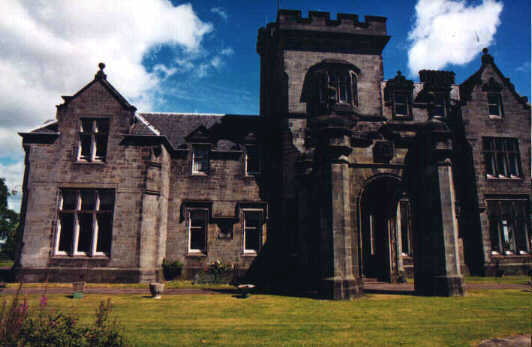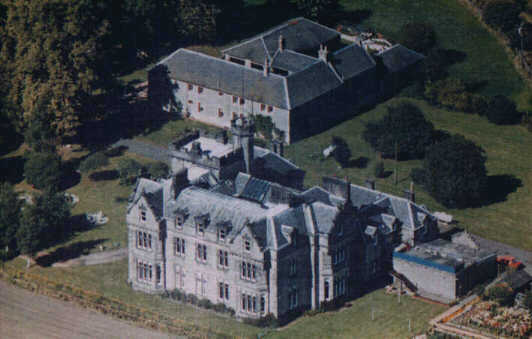Kinnaird House
(Stirlingshire)
 KINNAIRD, a village, in the parish of
Larbert, county of Stirlingshire, 3.5 miles (NW) from Falkirk. The village,
which is situated in the south of the parish, has arisen on the lands of Sir Michael
Bruce, Bart., whose seat is in the vicinity, from the quantity of coal underneath that
estate; and is chiefly inhabited by persons engaged in the collieries, and in the works of
the Carron Iron Company. The making of nails affords employment some of the inhabitants.
KINNAIRD, a village, in the parish of
Larbert, county of Stirlingshire, 3.5 miles (NW) from Falkirk. The village,
which is situated in the south of the parish, has arisen on the lands of Sir Michael
Bruce, Bart., whose seat is in the vicinity, from the quantity of coal underneath that
estate; and is chiefly inhabited by persons engaged in the collieries, and in the works of
the Carron Iron Company. The making of nails affords employment some of the inhabitants.
 KINNAIRD HOUSE is the home of the Bruces. It is
situated in an estate which lies about one mile north east of Stenhousemuir and was the
residence of the great Abyssinian traveller, James Bruce. He was the 18th century traveller
who discovered the source of the Blue Nile. He was born in Kinnaird House, spent his later
years, and died by a fall down the stairs in the house. James Bruce (1730-94) was the
sixth in descent from the Rev. Robert Bruce of Kinnaird (1559-1631), the noted
Presbyterian divine. Both are buried in the Lambert parish churchyard. A monument of iron,
cast at Carron, has been erected over his grave. His great granddaughter, Lady Elma Bruce,
the 8th Earl of Elgin's eldest daughter, in 1864 married the Lord Thurlow.
KINNAIRD HOUSE is the home of the Bruces. It is
situated in an estate which lies about one mile north east of Stenhousemuir and was the
residence of the great Abyssinian traveller, James Bruce. He was the 18th century traveller
who discovered the source of the Blue Nile. He was born in Kinnaird House, spent his later
years, and died by a fall down the stairs in the house. James Bruce (1730-94) was the
sixth in descent from the Rev. Robert Bruce of Kinnaird (1559-1631), the noted
Presbyterian divine. Both are buried in the Lambert parish churchyard. A monument of iron,
cast at Carron, has been erected over his grave. His great granddaughter, Lady Elma Bruce,
the 8th Earl of Elgin's eldest daughter, in 1864 married the Lord Thurlow.
The woodwork inside the house was
of beautiful, hand-carved and inlaid woods with an ornately carved ceiling. Two six feet,
or more, wide curved staircases descended from the second storey to the large parlour,
which was papered with heavy embossed maroon leather all in perfect condition.
The old mansion of Kinnaird does not seem to have
been older than the middle of the eighteenth century, although some parts may have been of
earlier date perhaps going back as far as the early years of the seventeenth century, when
Master Robert Bruce was the laird. The foundations of an old keep were found when the
eighteenth century house (Adan's style) was being pulled down. Nothing remains of the old
house now. The name Kinnaird in 1334 is said to mean (Gaelic, Cinn na h'airde) "at
the head of the height," which refers to its position in days when the sea came much
further in. The grounds are very picturesque, It has a very fine approach, where it widens
out near the house, with its stately avenue of trees, through which one sees the Ochil
Hills. On the wall of the garden there is a coat of arms with the date 1602 over the
shield, and the initials R.B. (Robert Bruce), and M.D. (Martha Douglas).
William Colvyl acquired the barony of Kinnaird in Stirlingshire.
The first known charter of
Kinnaird bears a date of 15th September, 1229, in the reign of Alexander II, when William
Colvyl gave land to the Abbot of Holyrood, Sir William Colvyl. He married Ada, daughter of
Malcolm Lockhart. In 1241 Ada Colvyl gave the lands of Kinnaird to the Abbey and monks of
Newbattle, for the souls' rest of David, Malcolm, and William, Kings of Scotland. Ada
Lockhart married firstly a. Sir John Moreham of that ilk. Their son, Adam de Moreham, in
1249 confirmed his mother's gift to the Abbey and designing her Ada de Colvyl. The Abbey
sold the lands in February, 1467, to Sir Alexander Bruce of Stenhouse & Airth. He gave
the estate to his third son, Edward.
Edward Bruce, first designer of
Kinnaird, was infeft in the lands of Kinnaird, 6th May, 1499. He married Christian or
Christina Stewart, one of the co-heiresses of her brother, David Stewart of Rosyth. They
had a son Edward de Brus of Kynnairde and in 1549 he became "Sir David Brus of
Kynnard".
The ancient tartan Bruce of Kinnaird comes from
the Bruce family of Kinnaird in Stirlingshire.
 KINNAIRD, a village, in the parish of
Larbert, county of Stirlingshire, 3.5 miles (NW) from Falkirk. The village,
which is situated in the south of the parish, has arisen on the lands of Sir Michael
Bruce, Bart., whose seat is in the vicinity, from the quantity of coal underneath that
estate; and is chiefly inhabited by persons engaged in the collieries, and in the works of
the Carron Iron Company. The making of nails affords employment some of the inhabitants.
KINNAIRD, a village, in the parish of
Larbert, county of Stirlingshire, 3.5 miles (NW) from Falkirk. The village,
which is situated in the south of the parish, has arisen on the lands of Sir Michael
Bruce, Bart., whose seat is in the vicinity, from the quantity of coal underneath that
estate; and is chiefly inhabited by persons engaged in the collieries, and in the works of
the Carron Iron Company. The making of nails affords employment some of the inhabitants.